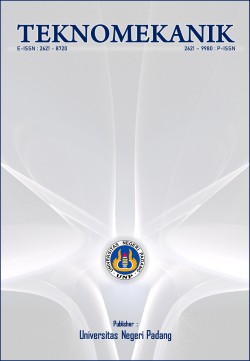Evaluation of E-learning at the Faculty of Engineering, Universitas Negeri Padang
DOI:
https://doi.org/10.24036/jptk.v5i1.26023Keywords:
E-learning, Evaluation, e-learning content, ERI 4.0, VocationalAbstract
Online learning can use an e-learning platform, e-learning content must be ideal and in accordance with the evaluation of the use of e-learning content. However, the gap that occurs is that e-learning content has never been started at Padang State University (UNP). The problems experienced by lecturers are not using content optimally, only using uploaded material, while content related to how to present material, learning methods in the use of e-learning and other content is not used. The purpose of this research is to make improvements to the implementation of e-learning in the UNP environment. The method used is a mixed method with quantitative and qualitative research, CIPP evaluation model, data collection using questionnaires. Based on the keywords from the CIPP evaluation results; 1) Context such as Principles, Goals, Environment, Needs. 2). Inputs such as e-learning delivery format, human resources (HR), User-friendly E-learning interface and service quality. 3) product category, namely Lecturer Competence. 4). Category of Lecturer Interaction Process, Teaching Method. The results of the survey obtained in Contexs have an average of 77.23, for input the average is 93.99, then the average process is 69.73, and the product is 68.25. So that it can provide recommendations for evaluating the implementation of e-learning by considering the process in the interaction section, on the product aspect of learning outcomes, on the input aspect the value is very good, then the component dimensions need to be improved.
Downloads
References
Al-Alwani, A. (2014). Evaluation criterion for quality assessment of E-learning content. E-Learning and Digital Media, 11(6), 532-542.
Coman, C., Țîru, L. G., Meseșan-Schmitz, L., Stanciu, C., & Bularca, M. C. (2020). Online Teaching and Learning in Higher Education during the Coronavirus Pandemic: Students’ Perspective. Sustainability, 12(24), 10367.
Creswell, J.W. 2013. Research Design: Pendekatan Kualitatif, Kuantitatif dan Mixed. Terjemahan Fawaid, A. Yogyakarta: Pustaka Pelajar
Dhawan, S. (2020). Online learning: A panacea in the time of COVID-19 crisis. Journal of Educational Technology Systems, 49(1), 5-22.
Drlik, M., & Skalka, J. (2011). Virtual faculty development using top-down implementation strategy and adapted EES model. Procedia-Social and Behavioral Sciences, 28, 616-621..
Irfan, M., Kusumaningrum, B., Yulia, Y., & Widodo, S. A. (2020). Challenges during the pandemic: use of e-learning in mathematics learning in higher education. Infinity Journal, 9(2), 147-158.
Krpan, D., & Stankov, S. (2009, September). Standards and Specifications for E-learning Systems. In 2009 International Symposium ELMAR (pp. 189-192). IEEE.
Leech, N., & Onwuegbuzie, A. (2009). A typology of mixed methods research designs. Quality and
Quantity: International Journal of Methodology, 43, 265–275
Lopez-Fernandez, O., & Molina-Azorín, J. F. (2011). The use of mixed methods research in interdisciplinary educational journals. International Journal of Multiple Research Approaches, 5(2), 269-283.
Means B, Toyama Y, Murphy R, Bakia M and Jones K. (2010) Valuation of evidencebased practices in online learning: a meta-analysis and review of online learning studies Washington D.C U.S. Department of Education.
Nasir,M. (2018). Peningkatan mutu vokasi dalam Menghadapi era revolusi industri 4.0 Kementerian Riset, Teknologi, dan Pendidikan Tinggi.
Sobaih, A.E.E.; Hasanein, A.M.; Abu Elnasr, A.E. Responses to COVID-19 in Higher Education: Social Media Usage for Sustaining Formal Academic Communication in Developing Countries. Sustainability 2020, 12, 6520
Sudira, P. 2018. Metodelogi Pembelajaran Vokasional Abad XXI. Yogyakarta: UNY Press.
Ozkan, S., & Koseler, R. (2009). Multi-dimensional students’ evaluation of e-learning systems in the higher education context: An empirical investigation. Computers & Education, 53(4), 1285-1296.
Tashakkori, A., & Teddlie, C. (1998). Mixed methodology. Combining qualitative and quantitative approaches. Thousand Oaks, CA: Sage.
Verawadina, U., Jalinus, N., Krismadinata, Widya, R.N., & Simeru, A. (2020). Needs Assessment of E-Learning Vocational Education. International Journal of Innovation, Creativity and Change, 11(4), 262–274.
Yulia, H. (2020). Online learning to prevent the spread of pandemic corona virus in Indonesia. ETERNAL (English Teaching Journal), 11(1).
Zubaidah (2016) S. 21st Century Skills: Skills Taught Through Learning. State University of Malang Journal, 1 (1): 1-17.
Downloads
Published
Issue
Section
License
Copyright (c) 2022 Fahmi Rizal, Unung Vera Wardina, Ambiyar Ambiyar

This work is licensed under a Creative Commons Attribution 4.0 International License.





